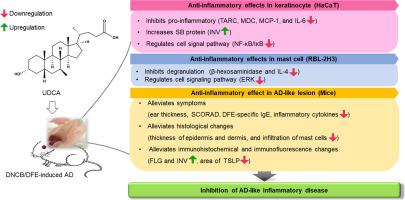Our official English website, www.x-mol.net, welcomes your feedback! (Note: you will need to create a separate account there.)
Ursodeoxycholic acid alleviates atopic dermatitis-associated inflammatory responses in HaCaT and RBL-2H3 cells and DNCB/DFE-treated mice
Life Sciences ( IF 6.1 ) Pub Date : 2024-03-13 , DOI: 10.1016/j.lfs.2024.122560 Eom Ji Kim , Hoyeon Park , Eun-Young Kim , Do Kyung Kim , Hyuk-sang Jung , Youngjoo Sohn
Life Sciences ( IF 6.1 ) Pub Date : 2024-03-13 , DOI: 10.1016/j.lfs.2024.122560 Eom Ji Kim , Hoyeon Park , Eun-Young Kim , Do Kyung Kim , Hyuk-sang Jung , Youngjoo Sohn

|
Ursodeoxycholic acid (UDCA) is a hydrophilic dihydroxy bile acid used for cholestatic liver disease and exhibits antioxidant, antitumor, and anti-inflammatory effects. However, its potential effects on atopic dermatitis (AD) have not been elucidated. This study aimed to evaluate the efficacy of UDCA in inhibiting the inflammatory response and alleviating lesions in AD-like mice. To investigate the efficacy of UDCA in AD-like inflammatory responses, tumor necrosis factor-alpha (TNF-α)- and interferon-gamma (IFN-γ)-stimulated HaCaT cells and anti-dinitrophenyl immunoglobulin E (DNP-IgE)- and human serum albumin (HSA)-stimulated RBL-2H3 cells were used to investigate the levels of inflammatory factors and their mechanisms. AD-like lesions were induced by applying DNCB/DFE to mice. The effect of UDCA administration in AD-like mice was analyzed by assessing organ weight, serum IgE and inflammatory cytokine levels, and histopathological changes using immunohistochemical and immunofluorescent staining. In HaCaT cells, UDCA significantly diminished TARC, MDC, MCP-1, and IL-6 expression by inhibiting the phosphorylation of nuclear NF-κB and cytoplasmic IκB, and also increased the levels of skin barrier protein. In RBL-2H3 cells, UDCA reduced β-hexosaminidase and IL-4 levels. In AD-like mice, UDCA suppressed organ hypertrophy, ear edema, SCORAD index, DFE-specific IgE levels, inflammatory cytokine levels, skin hypertrophy, mast cell invasion, skin barrier loss, and thymic stromal lymphopoietin-positive areas. UDCA suppressed the expression of pro-inflammatory cytokines by keratinocytes and mast cells. It also alleviated atopy by suppressing symptoms without organ toxicity in AD-like mice. UDCA may be an effective and safe treatment for AD.
中文翻译:

熊去氧胆酸减轻 HaCaT 和 RBL-2H3 细胞以及 DNCB/DFE 治疗小鼠中与特应性皮炎相关的炎症反应
熊去氧胆酸 (UDCA) 是一种亲水性二羟基胆汁酸,用于治疗胆汁淤积性肝病,具有抗氧化、抗肿瘤和抗炎作用。然而,其对特应性皮炎(AD)的潜在影响尚未阐明。本研究旨在评价UDCA抑制AD样小鼠炎症反应、减轻病变的功效。研究 UDCA 在 AD 样炎症反应、肿瘤坏死因子-α (TNF-α) 和干扰素-γ (IFN-γ) 刺激的 HaCaT 细胞以及抗二硝基苯基免疫球蛋白 E (DNP-IgE) 和人血清白蛋白(HSA)刺激的RBL-2H3细胞用于研究炎症因子的水平及其机制。通过对小鼠施用 DNCB/DFE 来诱导 AD 样病变。通过评估器官重量、血清 IgE 和炎性细胞因子水平以及使用免疫组织化学和免疫荧光染色的组织病理学变化来分析 UDCA 对 AD 样小鼠的影响。在HaCaT细胞中,UDCA通过抑制核NF-κB和细胞质IκB的磷酸化显着减少TARC、MDC、MCP-1和IL-6的表达,并且还增加皮肤屏障蛋白的水平。在 RBL-2H3 细胞中,UDCA 降低了 β-己糖胺酶和 IL-4 水平。在 AD 样小鼠中,UDCA 抑制器官肥大、耳水肿、SCORAD 指数、DFE 特异性 IgE 水平、炎性细胞因子水平、皮肤肥大、肥大细胞侵袭、皮肤屏障丧失和胸腺基质淋巴细胞生成素阳性区域。 UDCA 抑制角质形成细胞和肥大细胞促炎细胞因子的表达。它还通过抑制AD样小鼠的症状而减轻特应性,而没有器官毒性。 UDCA 可能是一种有效且安全的 AD 治疗方法。
更新日期:2024-03-13
中文翻译:

熊去氧胆酸减轻 HaCaT 和 RBL-2H3 细胞以及 DNCB/DFE 治疗小鼠中与特应性皮炎相关的炎症反应
熊去氧胆酸 (UDCA) 是一种亲水性二羟基胆汁酸,用于治疗胆汁淤积性肝病,具有抗氧化、抗肿瘤和抗炎作用。然而,其对特应性皮炎(AD)的潜在影响尚未阐明。本研究旨在评价UDCA抑制AD样小鼠炎症反应、减轻病变的功效。研究 UDCA 在 AD 样炎症反应、肿瘤坏死因子-α (TNF-α) 和干扰素-γ (IFN-γ) 刺激的 HaCaT 细胞以及抗二硝基苯基免疫球蛋白 E (DNP-IgE) 和人血清白蛋白(HSA)刺激的RBL-2H3细胞用于研究炎症因子的水平及其机制。通过对小鼠施用 DNCB/DFE 来诱导 AD 样病变。通过评估器官重量、血清 IgE 和炎性细胞因子水平以及使用免疫组织化学和免疫荧光染色的组织病理学变化来分析 UDCA 对 AD 样小鼠的影响。在HaCaT细胞中,UDCA通过抑制核NF-κB和细胞质IκB的磷酸化显着减少TARC、MDC、MCP-1和IL-6的表达,并且还增加皮肤屏障蛋白的水平。在 RBL-2H3 细胞中,UDCA 降低了 β-己糖胺酶和 IL-4 水平。在 AD 样小鼠中,UDCA 抑制器官肥大、耳水肿、SCORAD 指数、DFE 特异性 IgE 水平、炎性细胞因子水平、皮肤肥大、肥大细胞侵袭、皮肤屏障丧失和胸腺基质淋巴细胞生成素阳性区域。 UDCA 抑制角质形成细胞和肥大细胞促炎细胞因子的表达。它还通过抑制AD样小鼠的症状而减轻特应性,而没有器官毒性。 UDCA 可能是一种有效且安全的 AD 治疗方法。



























 京公网安备 11010802027423号
京公网安备 11010802027423号